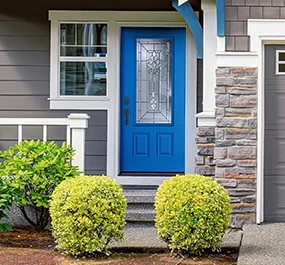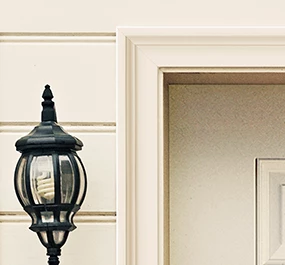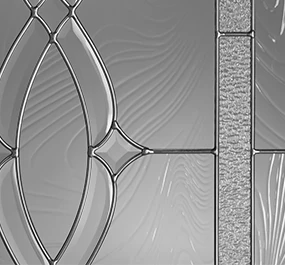Ideally, a front door will last as long as the home it’s part of, acting as a welcoming sight to family members and visitors—as well as a reliable source of protection from the people, sounds and weather conditions of the outside world. Things don’t always go according to plan, though, and sometimes a door that’s meant for a long tenure is considered for early retirement due to a number of different factors that could render it unable to perform its duties. In some cases, those factors lead to removal of the worn-down door and installation of a new one, while in other situations, a door can be saved by repairs.
The choice between door repair or replacement presents two drastically different decisions that can vary greatly when it comes to cost, time investment and overall longevity. That’s why it’s important to consider your options before beginning work on a door repair or replacement project.
Factors to Consider When Repairing or Replacing a Door
A sure sign of a door’s need for repair is its appearance. A dented, peeling or warping door isn’t just a cosmetic eyesore, it’s also a door showing outward signs of damage that’s easy to spot without much effort. There may also be issues that take a bit more scrutiny to uncover, such as damage to a door frame that isn’t necessarily visible from the front.
The material a door is made of can also impact the choice between door replacement or repair. Wooden door repair is usually an easier bit of DIY home improvement that can be completed without the help of a professional. Common repairs on a wooden door include filling scratches, cracks or small punctures created where a door made of steel would otherwise dent.
Speaking of steel, that dent won’t be as easy to fix if it happens in a steel door—it may not be possible for you or a professional to fix it at all. In that case, drastic damages will require a full door replacement.
No matter the door material, a chill emanating from your door probably means the weatherstripping needs to be replaced. Sometimes, old weatherstripping can become stiff and crack over time, but it can usually be replaced for less than the cost of a meal. Weatherstripping the bottom of a door may mean replacing the door’s jamb and installing a door sweep, which usually just means adhering a sweep to the bottom of the door. However, if the door is too warped or damaged to properly hang in its frame, that means your home is susceptible to the cold and other invaders. In this case, that door needs replacement.
Budget should be taken into account, too. Usually, the repair of an already existing door is a lot cheaper than the outright replacement of that door, but sometimes, damages are so great that repairs are out of the question and a door must be replaced in order for a home to remain secure. Be sure to list every single part of a repair or replacement project so no costs surprise you—every board, every nail and every hour of paid help, if necessary.
If a door is beyond repair, the budget for the project will need to be structured to allow for the outright purchase of a new exterior door.
Common Door Repair Solutions
If you like your door, you probably want to do everything you can to keep it—or, if you don’t like the possible price tag of replacing an old door, you’re probably doing everything you can to avoid it. Luckily, there are a number of solutions to the situations doors may find themselves in, and those repairs can be completed either on your own or with help from another.
Fixing a Sagging Door
A sagging door isn’t a door that’s doing its job, so repairs are in order.
Before moving on to the more complex steps of this project, first try to tighten any hinges that may have loosened up during the door’s years of use. For this first attempt at repair, you’ll only need a screwdriver.
Take your screwdriver—not a drill, as you run the risk of stripping your hinge’s screws—and tighten each of the screws on the door’s top hinge first. Work your way down to the bottom hinge, tightening any loose screws along the way. During this process, if you hear hinge pins rattle or feel them move, the hinge is most likely loose and must be replaced. If the other door hinges are in working condition, you’ll probably only need to replace the worn hinge to solve this issue.
Screws may also need replacing if they rotate endlessly instead of tightening snugly. Only replace the problem screws and measure your screw to check on length. If it’s 1-inch, replace it with a 1.5-inch screw.
Hinge spacers can also be the target of a sagging door. These spacers are used during installation to adjust and align the door, but if they shift or become damaged, they’ll need to be removed and replaced.
If these fixes fail to actually fix your sagging door, the issue may be an excess of stain or paint on the door itself. During its lifecycle, an older door may have already been the recipient of numerous coats. It’ll be laborious, but if there’s evidence those old layers are present, remove the door then remove each layer of door treatment. Screw the door back into its hinges and test it. Hinges may have bent due to the door’s weight and may need to be replaced. To avoid this issue, always remove old door treatments before applying new ones.
Fixing a Misaligned Door
Door Misalignment can be caused by a number of issues, including unexpected movement from hinges, wear, and warp. First, identify the problem. Then, apply possible solutions.
There’s a quick method of misalignment identification called the lipstick test, which allows you to find both the location and severity of the issue. Open the door in question and mark the edge of the deadbolt with lipstick. Next, turn the doorknob until the latch retracts, close the door and release when the latch barely touches the strike plate. If the lipstick makes a mark that doesn’t properly line up, its location in relation to the door may identify the issue.
If the mark is too high for the latch to be properly aligned, grab a screwdriver and tighten the door’s bottom hinges. Once again, don’t use a drill as you run the risk of stripping your hinge screws
If the mark landed more than one-eighth inch either above or below the hole in the strike plate, that plate itself may be causing a door misalignment because it’s either damaged or was improperly installed. Use a screwdriver to check the state of the plate’s screws. If they feel loose, tighten them and try the door again. If they’re already tight, you may need to attempt a slight plate adjustment.
Loosen the plate’s screws and insert the screwdriver into the plate’s hole. Using a hammer, tap the top of the screwdriver and maneuver the strike plate so it settles back into alignment. Perform this with caution. You’ll know it worked if the space between the door and its frame is evenly spaced. If the plate needs to move more than a little, you’ll need to remove the plate, create new screw holes—if old holes conflict, fill them with wood dowels—and move the plate.
As a last resort option, you may need to remove the door from its hinges, assess hinge placement and condition, then reattach the door.
Keep in mind that there are several other common door repairs that can be done without the help of a professional, including replacing a door slab or installing door planking. It all depends on your level of comfort with home repair. However, if you’re ever unsure about door repair or replacement, it can never hurt to consult a professional.
When to Replace a Door
A door that’s reached the end of its lifespan will most likely display outward signs of damage or loss of integrity. These include bowing or warping due to rain or humidity, difficulty opening and closing due to frame or door damage, and large holes or cracks.
When this occurs, consider a fiberglass replacement door that features a long lifespan, has high impact damage resistance, stands up to severe weather and makes your home more energy efficient. Plastpro’s fiberglass doors do all that while sporting a large array of customizable features that offer a number of different sizes and fit a lot of architectural styles.
Upgrading Your Door with Plastpro
Repair is certainly an appealing option when things start to go wrong with your exterior door, and that should be the first thing you try. However, if the door is older or the issue is severe, each repair project will have diminishing returns.
Plastpro’s fiberglass doors sport all the aforementioned features, plus their sturdy design and enhanced durability mean they’re low maintenance doors that can save you from years of door-related home improvement projects. Additionally, if you’re already planning to replace a door, Plastpro’s fiberglass doors are priced competitively. Find a Plastpro dealer to explore door replacement options.



